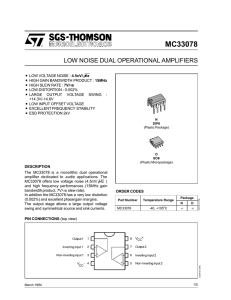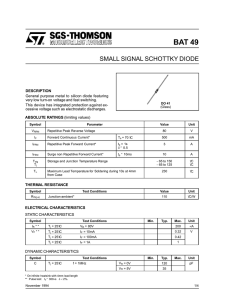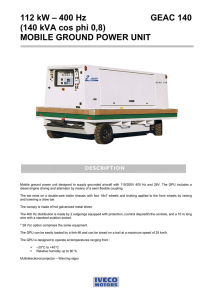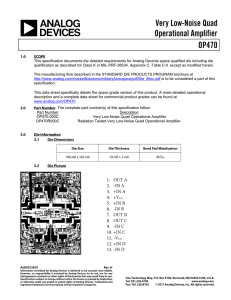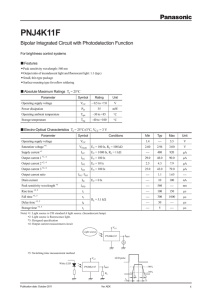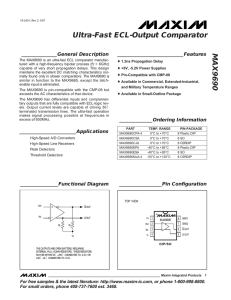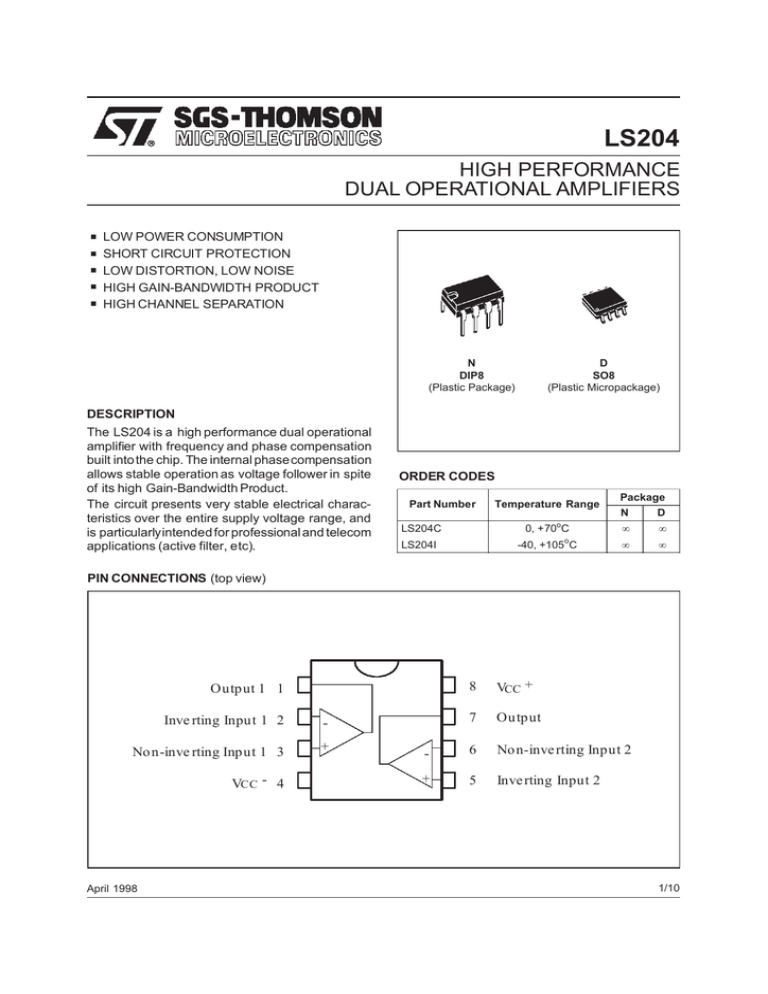
LS204
HIGH PERFORMANCE
DUAL OPERATIONAL AMPLIFIERS
..
..
.
LOW POWER CONSUMPTION
SHORT CIRCUIT PROTECTION
LOW DISTORTION, LOW NOISE
HIGH GAIN-BANDWIDTH PRODUCT
HIGH CHANNEL SEPARATION
N
DIP8
(Plastic Package)
DESCRIPTION
The LS204 is a high performance dual operational
amplifier with frequency and phase compensation
built intothe chip. The internal phasecompensation
allows stable operation as voltage follower in spite
of its high Gain-Bandwidth Product.
The circuit presents very stable electrical characteristics over the entire supply voltage range, and
is particularlyintended for professional and telecom
applications (active filter, etc).
D
SO8
(Plastic Micropackage)
ORDER CODES
Part Number
LS204C
Temperature Range
N
D
0, +70oC
•
•
o
•
•
-40, +105 C
LS204I
Package
PIN CONNECTIONS (top view)
8
VCC +
7
Output
-
6
Non-inve rting Input 2
+
5
Inve rting Input 2
Output 1 1
Inve rting Input 1 2
-
Non-inve rting Input 1 3
+
VCC - 4
April 1998
1/10
LS204
SCHEMATIC DIAGRAM (1/2 LS204)
ABSOLUTE MAXIMUM RATINGS
Symbol
Value
Unit
Supply Voltage
±18
V
Vi
Input Voltage
±VCC
Vid
Differential Input Voltage
VCC
± (VCC - 1)
Operating Temperature Range
Ptot
Power Dissipation at Tamb = 70oC
500
Junction Temperature
150
o
-65 to +150
o
Tstg
Storage Temperature Range
LS204C
LS204I
0 to +70
-40 to +105
o
Toper
Tj
2/10
Parameter
C
mW
C
C
LS204
ELECTRICAL CHARACTERISTICS (VCC = ±15V, Tamb = 25oC, unless otherwise specified)
Symbol
Parameter
Test Conditions
LS204I
Min.
Typ.
LS204C
Max.
Min.
Typ.
Max.
Unit
ICC
Supply Current
0.7
1.2
0.8
1.5
mA
Iib
Input Bias Current
50
150
100
300
nA
Ri
Input Resistance
Vio
Input Offset Voltage
Tmin. < Top < Tmax.
300
f = 1kHz
Rs ≤ 10kΩ
0.5
Rs ≤ 10kΩ
Tmin. < Top < Tmax.
DVio
Iio
Input Offset Voltage Drift
Ios
Output Short Circuit Current
Avd
Large Signal Voltage Gain
GBP
en
2.5
0.5
2
5
12
40
Tmin. < Top < Tmax.
nA
°C
23
23
mA
90
100
95
86
100
95
Gain-Bandwidth Product
f = 100kHz
1.8
3
1.5
2.5
Equivalent Input Noise Voltage
f = 1kHz
Rs = 50Ω
Rs = 1kΩ
Rs = 10kΩ
dB
8
10
18
15
10
12
20
0.03
0.1
0.03
Output Voltage Swing
RL = 2kΩ VCC = ±15V
VCC = ±4V
Vopp
Large Signal Voltage Swing
RL = 10kΩ f = 10kHz
Slew Rate
Unity Gain, RL = 2kΩ
0.8
Common Mode Rejection Ratio
Vic = 10V
Tmin. < Top < Tmax.
90
86
Vic = 1V f = 100Hz
Tmin. < Top < Tmax.
90
86
f = 1kHz
100
Channel Separation
nA
nA
0.1
±Vopp
VO1 /VO2
50
100
0.08
Tmin. < Top < Tmax.
RL = 2kΩ VCC = ±15V
VCC = ±4V
Supply Voltage Rejection Ratio
µV/ C
2
20
AV = 20dB R L = 2kΩ
VO = 2VPP f = 1kHz
SVR
mV
o
Rs ≤ 10kΩ
Tmin. < Top < Tmax.
Total Harmonic Distortion
SR
3.5
5
THD
CMR
nA
MΩ
mV
Tmin. < Top < Tmax.
Input Offset Current Drift
1
3.5
Input Offset Current
DIio
700
1
±13
±3
±13
±3
MHz
nV
√
Hz
0.1
%
V
28
28
VPP
1.5
1
V/µs
dB
dB
120
120
dB
3/10
LS204
4/10
LS204
5/10
LS204
APPLICATION INFORMATION :
Active low-pass filter
BUTTERWORTH
The Butterworth is a ”maximally flat” amplitude
response filter (figure 10) Butterworth filters are
used for filtering signals in data acquisition systems
to prevent aliasing errors in samples-data applications and for general purpose low-pass filtering.
The cut-off frequency Fc, is the frequency at which
the amplitude response is down 3dB. The attenuation rate beyond the cutoff frequency is n6 dB per
octave of frequency where n is the order (number
of poles) of the filter.
Other characteristics :
Flattest possible amplitude response
Excellent gain accuracy at low frequency end
of passband
..
BESSEL
The Bessel is a type of ”linear phase” filter. Because of their linear phase characteristics, these
filters approximate a constant time delay over a
limited frequency range. Bessel filters pass transient waveforms with a minimum of distortion. They
are also used to provide time delays for low pass
filtering of modulated waveforms and as a ”running
average” type filter.
−nΠ
The maximum phase shift is
radians where n
2
is the order (number of poles) of the filter. The
cut-off frequency fc, is defined as the frequency at
which the phase shift is one half of this value. For
accurate delay, the cut-off frequency should be
twice the maximum signal frequency.
The following table can be used to obtain the -3dB
frequency of the filter.
-3dB Frequency
.
..
2 Pole
4 Pole
6 Pole
8 Pole
0.77fc
0.67fc
0.57fc
0.50fc
Other characteristics :
Selectivity not as great as Chebyschev or Butterworth
Very little overshoot response to step inputs
Fast rise time
CHEBYSCHEV
Chebyschev filters have greater selectivity than
either Bessel ro Butterworth at the expense of
ripple in the passband (figure 11).
Chebyschev filters are normally designed with
peak-to-peak ripple values from 0.2dB to 2dB.
Increased ripple in the passband allows increased
attenuation above the cut-off frequency.
The cut-off frequency is defined as the frequency
at which the amplitude response passes through
the specificed maximum ripple band and enters the
stop band.
Other characteristics :
Greater selectivity
Very non-linear phase response
High overshoot response to step inputs
..
.
The table below shows the typical overshoot and settling time response of the low pass filters to a step input.
Number of
Poles
Peak
Overshoot
Settling Time (% of final value)
% Overshoot
±1%
±0.1%
±0.01%
Butterworth
2
4
6
8
4
11
14
16
1.1Fcsec.
1.7/fc
2.4/fc
3.1/fc
1.7Fcsec.
2.8/fc
3.9/fc
5.1/fc
1.9Fcsec.
3.8/fc
5.0/fc
7.1/fc
Bessel
2
4
6
8
0.4
0.8
0.6
0.1
0.8/fc
1.0/fc
1.3/fc
1.6/fc
1.4/fc
1.8/fc
2.1/fc
2.3/fc
1.7/fc
2.4/fc
2.7/fc
3.2/fc
Chebyschev (ripple ±0.25dB)
2
4
6
8
11
18
21
23
1.1/fc
3.0/fc
5.9/fc
8.4/fc
1.6/fc
5.4/fc
10.4/fc
16.4/fc
-
Chebyschev (ripple ±1dB)
2
4
6
8
21
28
32
34
1.6/fc
4.8/fc
8.2/fc
11.6/fc
2.7/fc
8.4/fc
16.3/fc
24.8/fc
-
Design of 2nd order active low pass filter (Sallen and Key configuration unity gain-op-amp)
6/10
LS204
7/10
LS204
8/10
LS204
PACKAGE MECHANICAL DATA
8 PINS - PLASTIC DIP
Dim.
Millimeters
Min.
A
a1
Typ.
Inches
Max.
Min.
3.32
Typ.
Max.
0.131
0.51
0.020
B
1.15
1.65
0.045
0.065
b
0.356
0.55
0.014
0.022
b1
0.204
0.304
0.008
D
E
0.012
10.92
7.95
9.75
0.430
0.313
0.384
e
2.54
0.100
e3
7.62
0.300
e4
7.62
0.300
F
6.6
0260
i
5.08
0.200
L
Z
3.18
3.81
1.52
0.125
0.150
0.060
9/10
LS204
PACKAGE MECHANICAL DATA
8 PINS - PLASTIC MICROPACKAGE (SO)
Dim.
A
a1
a2
a3
b
b1
C
c1
D
E
e
e3
F
L
M
S
Min.
Millimeters
Typ.
0.1
0.65
0.35
0.19
0.25
Max.
1.75
0.25
1.65
0.85
0.48
0.25
0.5
Min.
Inches
Typ.
0.026
0.014
0.007
0.010
Max.
0.069
0.010
0.065
0.033
0.019
0.010
0.020
0.189
0.228
0.197
0.244
0.004
45o (typ.)
4.8
5.8
5.0
6.2
1.27
3.81
3.8
0.4
0.050
0.150
4.0
1.27
0.6
0.150
0.016
0.157
0.050
0.024
o
8 (max.)
Information furnished is believed to be accurate and reliable. However, SGS-THOMSON Microelectronics assumes no responsibility
for the consequences of use of such information nor for any infringement of patents or other rights of third parties which may result
from its use. No license is granted by implication or otherwise under any patent or patent rights of SGS-THOMSON Microelectronics.
Specifications mentioned in this publication are subject to change without noti ce. This publication supersedes and replaces all
information previously supplied. SGS-THOMSON Microelectronics products are not authorized for use as critical components in life
support devices or systems without express written approval of SGS-THOMSON Microelectronics.
1998 SGS-THOMSON Microelectronics – Printed in Italy – All Rights Reserved
SGS-THOMSON Microelectronics GROUP OF COMPANIES
Australia - Brazil - Canada - China - France - Germany - Italy - Japan - Korea - Malaysia - Malta - Morocco
The Netherlands - Singapore - Spain - Sweden - Switzerland - Taiwan - Thailand - United Kingdom - U.S.A.
10/10


